This article will explain the steps required to setup and trigger an audit notification.
NOTE: In order to add Notifications, the person setting these up must have the
appropriate role and functional permissions to view the notification polices
and queue pages, as well as have the appropriate notification entity rights to
view, add, delete, and edit notifications.


For this document, we will assume the appropriate Account Role has already
been established.
Adding Notifications and Policies:
You can set up IMPOWR to receive notifications, like alerts, any time data is
added or changed.
Note: Notifications can only set up for actions which are captured in the
Audit Trail (System > IT Management > Audit Trail)
- Login to your IMPOWR website.
- Go to the System menu.
- Click on Notification Policies in the IT Management section.
Entering a Notification Policy
- Click New.
 **
**
- Select the kind of notification you would like to create and click Create.
In this case, click on the Create button on the Audit Notification row.
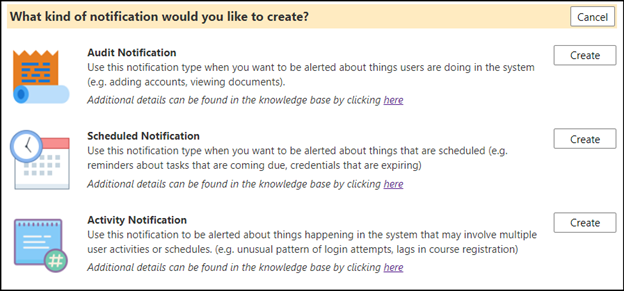
Audit Notifications
These kinds of notifications are triggered by events which occur in the
system, such as the addition or deletion of a client, or the update of an
incident, etc.
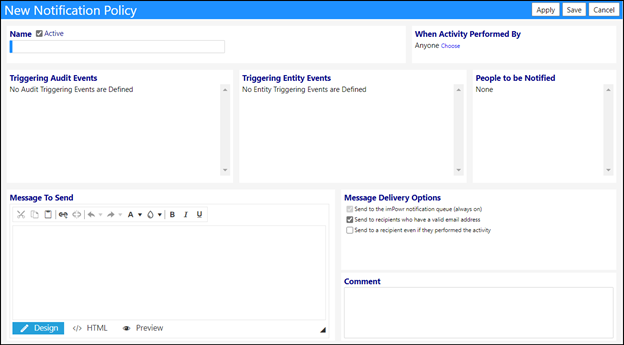
Enter the Name
- Enter the Name of the new Notification.

- Check if the Notification is Active (if left unchecked, the notification will not be implemented).
Triggering Audit Notifications
Enter the Initiator of the Trigger
- Identify when the Notification will be initiated when someone performs an action by selecting that person (i.e., the trigger of the notification initiates when an activity is performed by an individual).
- Click on Choose or leave as defaulted (Anyone).

- If you choose to select who performs the activity, Choose Staff Member from the list by highlighting the staff member’s name and clicking Select.

- Click Apply to activate the rest of the form.

Once you have clicked on Apply, you can now enter in the triggering
events, the people to be notified, the message to be sent, and your message
delivery options.
Enter the Triggering Event
There are two ways to trigger the notification – either it is triggered by an
Audit Event (any time an entry is captured in the Audit Trail) or when it
is triggered by an Entity Event (these are the selected activities (View,
Add, Edit, and/or Delete) for one of the entities in the imPowr program). (As
noted previously, Entity Rights (actions) are set in the Account Role.)
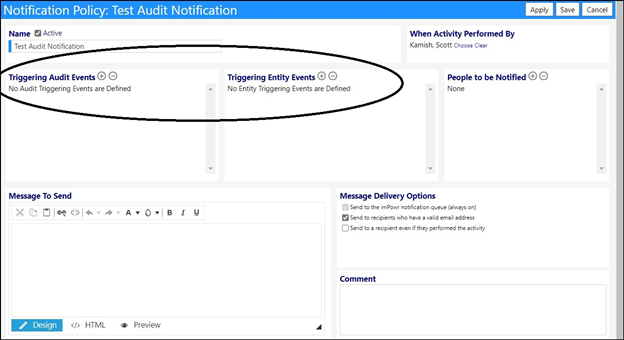
The reason there are Entity Events is because someone may want to track only
when a specific action occurs such as when something is deleted, for example,
versus sending a notification when_ any_ change occurs.
Triggering Audit Events:

- Click on the ‘+’ to add a triggering Audit Event.

- Choose an “Add”, “Delete”, “Update”, “Access”, or “Issue” Audit Event(s) from the Choose Audit Event list by checking the box to the left of the Audit Event.
- Click Save.


Note: to Delete an existing event, select the event from the list by
checking the box to the left of the Event name and clicking on the ‘-‘ button.

Example: Assume I want to be notified any time an Organization is Deleted. To
do so, I would select Organization Delete and click on Save.

- The triggering event will now be displayed:
NOTE: sometimes, you only want to trigger the notification policy based on a subset of the entities. For example, you might want to trigger the notification based on vehicle assets versus triggering it on All assets. For this, we have something called Qualifiers. The Qualifiers allow you to establish the subset. To access those, click on the icon to the right of the Triggering Audit Event. If you wish to add these, please work with your Continual Care Solutions Account Manager.

NOTE: more than 1 triggering event can be added. For example, maybe you want to be notified when something is updated or deleted.
Enter the People to be Notified
- Select the People to be Notified by clicking on the ‘+’.

- Choose Staff Member from the list by checking the box to the left of their name and clicking Save.

NOTE: Multiple people can be selected to be notified.
 _
_
Note: to Delete a Person to be Notified, check the box to the left of the
selected person(s) and clicking on the ‘-‘ button.

Enter a Notification Message
- Enter your Message to Send.
Example:

NOTE: Reserved words can be used in your message.
Select Message Delivery Options
- Select your** Message Delivery Options.**
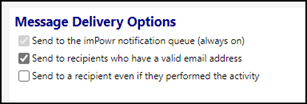
- The **Send to the IMPOWR notification queue **(always on) defaults to being selected and cannot be de-selected.
- Select the **Send to recipients who have a valid email address **so only users with a valid email address will receive the notification.
- Select the Send to a recipient even if they performed the activity if you desire that option (in most cases, people who did the activity are already aware of it, so they do not want to be notified, but in other cases, users might select this just to know when a notification policy was triggered and the notification was emailed out).
Enter a Comment
- Enter a Comment about your Notification Policy if desired.
Example:

NOTE: this comment does not display anywhere except in the list of
Notification Policies.
Save your Notification Policy
- Click Save.
Notification Policies List
The New Notification Policy now appears in the Notification Policy List under
both the All tab and the Audit tab:

Activate the Notification
If the notification is not already activated for use…
- Click on the Notification ID.
- Check the Active box, above the Notification Name.

- Click Save.
The notification is now saved and activated (i.e., ready to be triggered).
Triggered Audit Notifications
Once the notification policy for an Audit Notification is triggered, it will
not only send the notification to the intended recipient(s), but that sending
will also be captured in the Notifications List.
In the above example, any time an Organization is Deleted by Scott Kamish, he
and others will receive a notification informing them of the deletion.
Notifications List
Whenever a Notification is created, it appears on the Notifications page (Go
to the Performance menu and click on Notifications in the Communications
section):

The Notifications page displays the date the Notification was sent, to whom,
the related entity and the source.
Users can choose to display All Notifications for a specific time frame, for a
specific Recipient, for a specific Audit Event (Related Entity), or a specific
Triggering Entity Event (Source Policy).
They can also choose to only display:
- Notifications sent to me
- Notifications about my account
- Accounts I case manage, or issues I submitted or own

Example:
Organization 06383 (AAA Organization) was deleted.
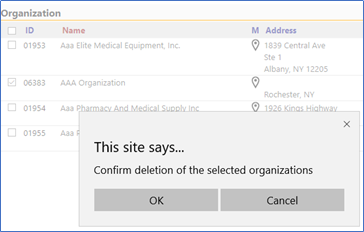
- Click on Ok
The Organization now been deleted and almost immediately, a Notification was
created and sent via email to the intended recipient…
The emailed Notification states:
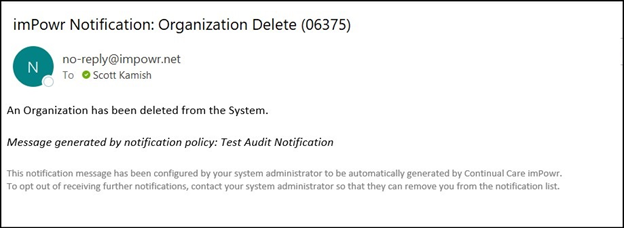
Viewing the Notifications List
The sent Notification appears in the list of notifications.

NOTE: the “New” indicator to the left of the Notification ID indicates the
notification is new and has not been viewed yet.
Looking at the list, we can see Organization 06375 was deleted and that the
notification was generated from the Test Audit Notification (i.e., the Source
Policy).
- Clicking on the Notification ID, the details of the notification can be viewed, displaying the message that was entered as well as the source of the notification:
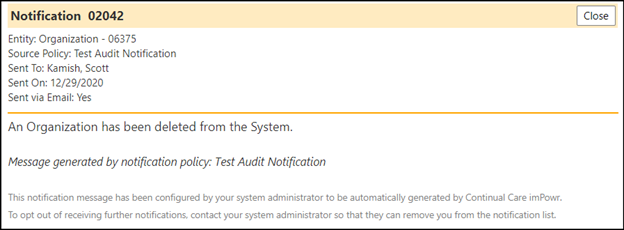
Once read, the ‘New’ changes to a checkmark, indicating the notification has
been viewed:

Viewing the Audit Trail
Looking at the Audit Trail (Go to the System menu and click on Audit
Trail in the IT Management section).
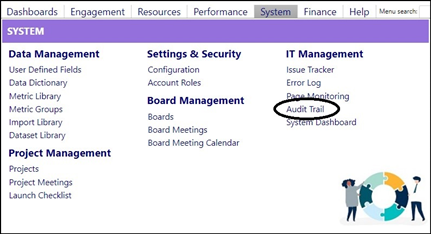
We can view the name, date, and time the action took place (when the
notification was triggered), as well as the person who performed the action
(in this case, it was the person who deleted the organization):

Note: the Audit Trail also captured when the notification policy was
created and changed:
